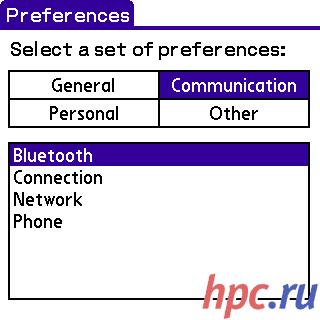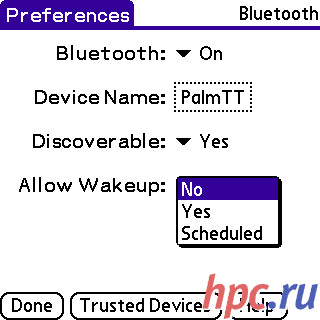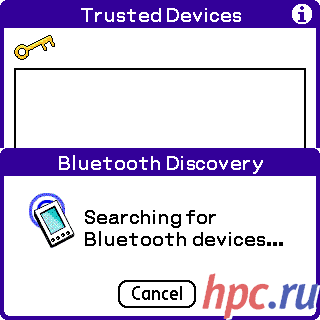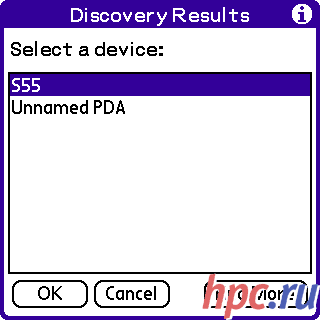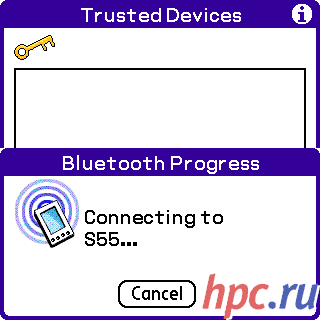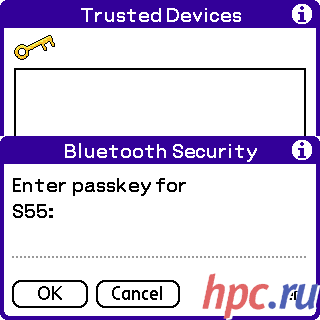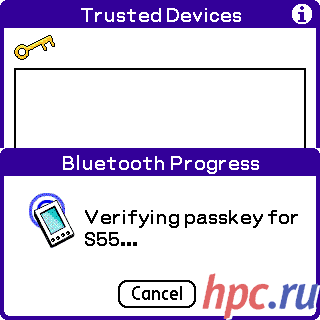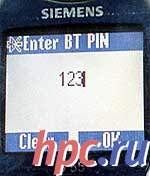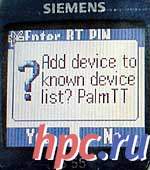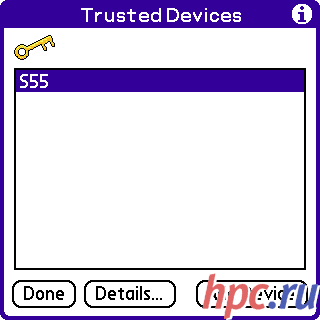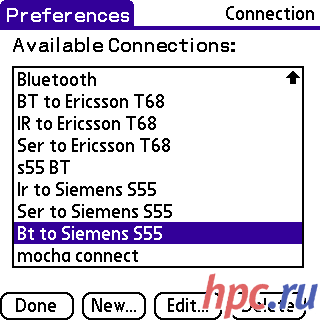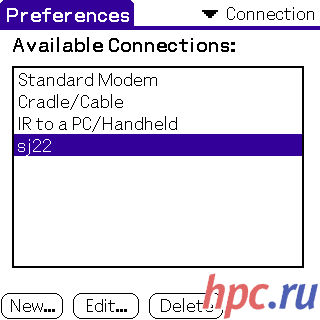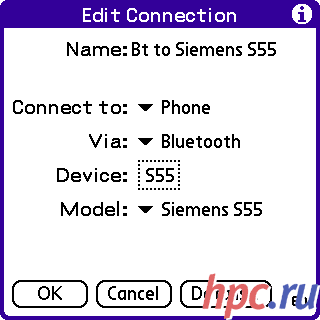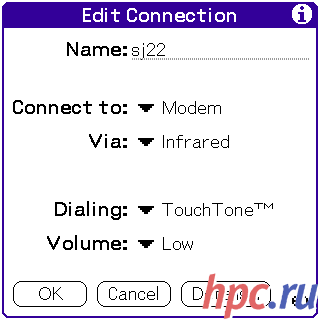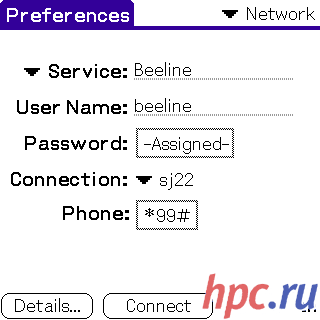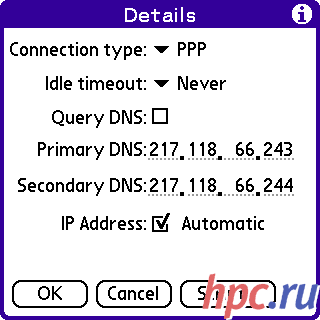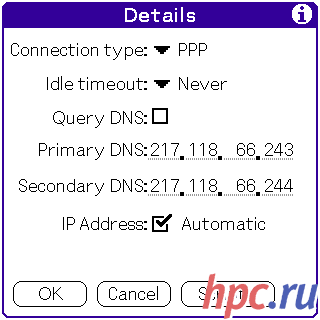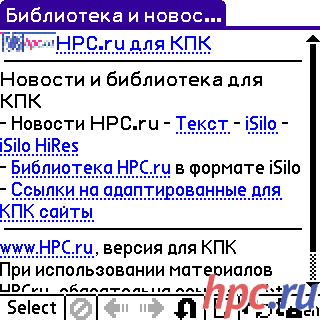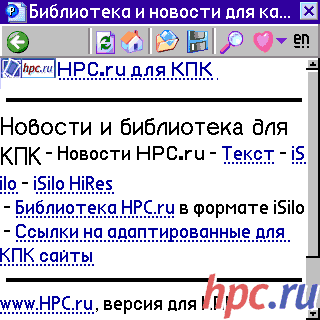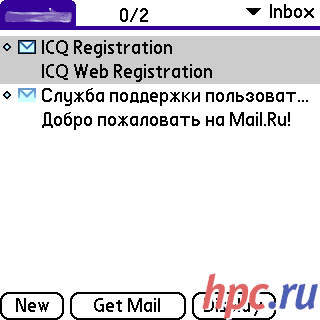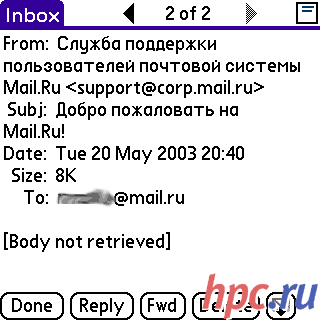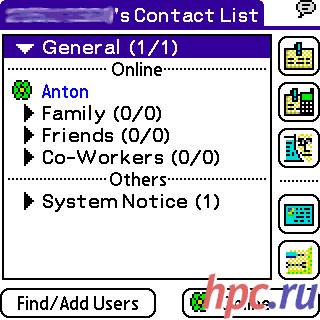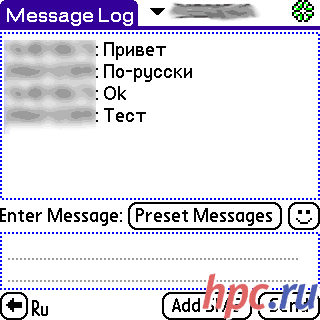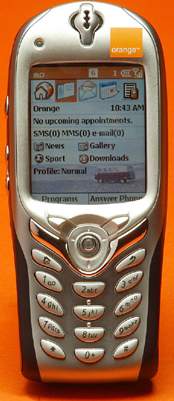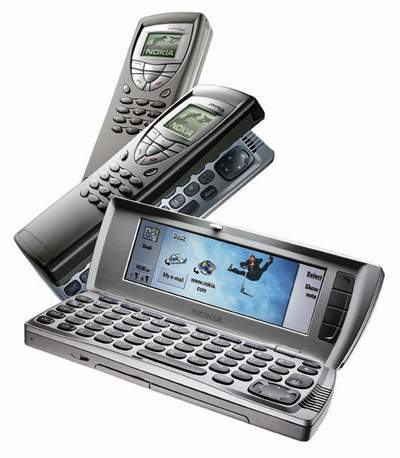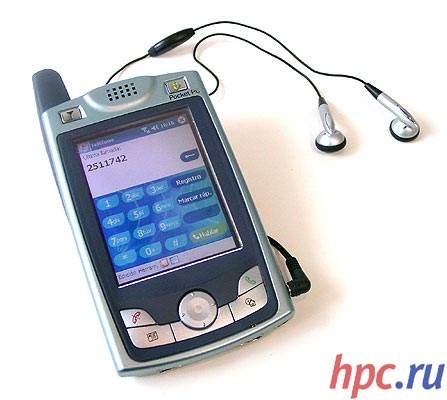Tip: In addition to this article read other thematic materials HPC.ru
What is it - GPRS?
For all its contemporary theoretical and practical bases of GSM have been developed for a long time and largely behind the users' requirements. The current data rate in these networks - 9.6 kilobits per second (1,2 KB / s). Even under the most modest needs such speed can not provide a complete work. In addition, with this method of connection fee is to wait. In the present situation, when many people need to be always on-line is absolutely unprofitable. To remedy the situation, at one time, a new data transfer protocol in mobile networks, which received a resounding title GPRS (General Packet Radio Service - the packet data service over the air). As seen from the explanation of the abbreviations, the transfer is "packets", ie not used all the radio, on which there is also a voice, but pauses that occur during the transmission of voice information. The phone can handle multiple channels simultaneously - both the reception and data transfer. The new protocol will dramatically increase the speed - ideally - to 171.2 Kbps. In reality, the speed is limited capabilities of terminals, ie handsets. Modern tube can use up to 2 channels for the transfer - about 13 kbit / s and up to 4 to receive data - about 40 kbps (5 KB / s). In many ways, the connection speed is determined and the overall workload of the network. It is important that the GPRS-connection fee is charged based on the number of incoming and outgoing information, rather than time. That is, users of GPRS if you want can always be connected to the internet, because he pays only for traffic. This kind of access is much easier, and cheaper than traditional GSM-speed data transfer.
Mobile Internet: PDA or handset?
Manufacturers of mobile phones today are building into their products a lot of additional tools: an organizer, phone book, to-do list, games. And often, of course, GPRS. With the tube becomes possible to learn the schedule of the aircraft, weather forecast, currency rates and much more. Your mobile phone can be connected to global networks, and this opens up broad prospects. But this raises the issue of quality user experience with the Internet. Screens of mobile phones today are extremely low, so a full-fledged surfing the net is almost impossible. Of course, there are sites that are adapted for viewing on small screens, but it's mostly dry information sources that provide background information or at best a summary of the latest news. And what about chat rooms, forums, ISQ? A good idea to get access to data and remote home or office computer, and use the full email client, which can, for example, display, save, and send email attachments. But would still need to work with Web pages without going through all the links one by one the phone button, but simply pointing to the right as on the desktop ... Ah! .. All this mobile phones, unfortunately, are not able. There are not going to use something else other than a mobile phone. Options are not too many: laptop, desktop, or PDA (personal computer). The most powerful tool will, of course, laptop. He is mobile and the most versatile. But the laptop - it's more than 800 dollars a kilogram minimum weight, it is a decent size, it's about 2-3 hours (the more expensive models have worked for longer). Besides all the above, the laptop does not use on the go. It necessarily have to open and wait until the system boots or come out of hibernation. The second option - it's handhelds. All the advantages and disadvantages here to mirror the situation with laptops. Pocket PC today is inexpensive - from $ 200, but the average price of a typewriter for a good price / quality ratio - $ 300 PDA weighs only 150-200 grams, it is flat and quietly fit in your pocket, it is very convenient to carry in a belt or cheholchike purse. Battery life varies widely, averaging 5 to 12 hours (net time!). PDA enabled instantly: got, clicked the button work. Practice shows that the PDA is quite resistant to accidental drops, vibration, rain.The touch screen and control buttons make the work enjoyable, with many actions you can do with just one hand. When you visit Internet resources ligament PDA + phone provides a lot more than just a mobile phone that supports GPRS. A relatively large screen, ample opportunities for input, the ability to install additional software, support for today's Internet technology - all this speaks in favor of the CCP. In many cases, the network can use services with the same ease as on the desktop. For PDAs, there are versions of popular programs such as ICQ, Windows Messenger, etc. But, nevertheless, the possibility of handhelds are not limitless. When working with network resources frequently encountered problem with displaying national symbols, and many handheld browsers will not be able to automatically detect the page encoding to spend a lot of time on the repartitioning of pages for viewing on a small screen, can not work with animated images. Nevertheless, for mobile surfing on the go, anywhere - the best solution to date is not there. Although, in fairness, it is worth mentioning another class of devices - smartphones - a sort of hybrid mobile phone and a full-fledged handheld computer. But we tell about them below.
Several ways to combine a PDA with a mobile phone
Link PDA with a mobile phone in several ways. Typical estimates of each method can be easy connectivity, reliability, convenience and, of course, price. Let us consider all possible types of connection. Firstly, it is a direct cable connection. Special devices are connected to cable via serial ports. This connection could be considered the most reliable and cheap, but given the variety of PDAs and cell phones on the market, such a method will be most difficult. The developers did not seek to unify the devices, and virtually every new model has its own interface and connector. Of course, you can try to find a suitable model of PDA and phone, search for shops or solder a very appropriate cable, but it's too expensive. Cable connection is not convenient (imagine that your PDA and phone all the time, connect the wires) and virtually a thing of the day before yesterday afternoon. Therefore, in this review, the cable connection is not considered. A more common way to make friends PDA and cell phone - it's an infrared port (IrDA). Device "wink" to each other rays bottom of the spectrum, not visible to the human eye. Such a combination is used for a long time and was very widespread. Almost all PDA models have this port, and you just have to pick up the appropriate receiver. The process itself will be discussed in detail hereinafter. Looking ahead we can say that this method is the most inexpensive of the above. However, there will have to live with some restrictions mobility ligament - a device constantly need to be in direct line of sight to each other at a distance of no more than 2 meters. To use such a bunch on the run, will require considerable skill. In addition, in very bright light and sunshine connection on the IR port will be difficult.
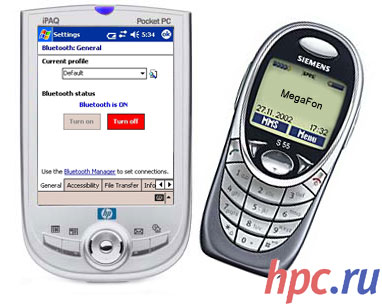 |
And the third possible way to combine - it's communication at radio frequencies, when using Bluetooth. Bluetooth - a high-speed microwave standard that allows data transfer at up to 10 meters (in practice more). Clocked at 2,56 Ghz and is able to simultaneously connect up to 8 devices in one group. The main charm of Bluetooth - a sufficiently high exchange rate and the time that the devices need not be in the line of sight. No need to worry that someone can connect to your phone via Bluetooth and will "sit" on the internet your money. User-level protection against unauthorized access to your device is organized with multiple levels of trust that can be set independently.The highest level - Trusted. In this mode, the owners of Bluetooth devices once spend on their typewriters special authorization procedure, after which the devices can exchange data without asking for additional evidence. Lower level - Discoverable. In this mode, your Bluetooth device is visible to all others who are in range. However, all manipulations with data transfer require you to confirm. And finally, there is almost completely hidden mode when your PDA can not be found. In this mode, it will only communicate with the Trusted devices, if any. At the moment the technology is becoming more widespread, and these modules are integrated into an increasing number of devices - from watches to refrigerators. Minus - pretty high price for the device with built-in Bluetooth-modules, because basically these modules are equipped with top models of equipment. However, the situation is gradually getting better, and the standard, finally, may well become nationwide. For example, the latter belonging to the class cost model iPAQ h1945 Pocket PC equipped with such a module.
 |
If the PDA does not have full-time wireless data transmission capabilities, it is quite simply "cured" through an optional module in the slot the PDA. The procedure to install the Bluetooth connection in some cases even easier than IrDA, and will also be discussed in detail hereinafter. In terms of ease of use, "Blue tooth" of course, be the first place. To access the Internet, you will not even get the phone from his pocket. In transport, on the street, at work, at home and study you will always be on-line. With the help of special software can work with text messages and make calls directly from the PDA. Chances are, of course, very broad, but, as mentioned above, it is worth the money.
Test Equipment
For comparative testing, we got a few different PDA platforms and price groups. When you connect to the internet via GPRS services used mobile operator Beeline. Test Equipment:
1. Pocket PC platform
a. Toshiba e755 (about $ 700) (the highest price category) - Pocket PC 2002; XScale PXA 255 processor, 400Mhz; RAM 96 MB, ROM 32 MB; Slots SD, CF; Ports IrDA and Wi-Fi; Screen 240x320, 65000 colors; battery 1000 mAh; 190 grams
b. Dell Axim X5 Basic (around $ 315) (middle-lower-price category) - Pocket PC 2002 Processor Xcsale PXA 250 300 Mhz; ROM 32 MB, RAM 32 MB; Slots SD, CF; Port IrDA; Screen 240x320, 65000 colors; battery 1440 mAh; 190 grams
c. Eten P603 (around $ 700) (middle-lower-price category of communicators) - Pocket PC 2002 Phone Edition; GSM / GPRS 900/1800/1900 MHz type B, class 10; processor StrongARM SA-1100 206 Mhz; ROM 32 MB, RAM 64 MB Slot SD / MMC; Port IrDA; Screen 240x320, 65000 colors; Li-ion battery
d. Bluetooth-module Pretec BT slot Compact Flash ($ 99), 30 grams
2.Platforma Palm
a. Palm Tungsten T ($ 350) (average price category) - Palm OS 5 Processor Texas Instruments OMAP1510, 175 MHz; RAM 16 MB, ROM 4 MB, slot SD / MMC; Ports IrDA and BlueTooth 1.1; Screen 320x320, 65000 colors , 160 grams
b. Sony Clie SJ-22 (about $ 230) (low price category) - Palm OS 4.1; processor Motorola Dragonball, 33 MHz; RAM 16 MB, ROM 4 MB, Slot Memory Stick; Port IrDA; Screen 320x320, 65000 colors, 140 grams
3. Cell Phones
a. Siemens S55 (okolo300 $) - Bluetooth, Infrared, GPRS
b. Ericsson T68 (okolo190 $) - Bluetooth, Infrared, GPRS
c.LG G7000A (around $ 330) - IrDA, GPRS
4. Software Pocket PC
a. Crack - Pocket Russkey Lite
b. Driver Pretec BT v1.36
c. Browser - Built-in standard Pocket Internet Explorer
d. E-mail client - built-in standard Inbox
5. Programs Palm OS
a. Crack - PaPiRus (for Sony Clie, to Palm OS 5) and PaPiRus 2003 (for the Palm TT, for Palm OS 5 and above)
b. Agents - Xiino and PocketLink
c. Mail Client - VersaMail (Standard Delivery)
Setting up the IR port and GPRS on Pocket PC 2002, Internet access
As already mentioned, the infrared connection is used for a long time. To connect the device to activate the infrared port on both devices, put them next to each other and make some adjustment. The operating system Pocket PC 2002 support for IrDA is initially, ie no need to install any drivers. Before connecting, be sure to check if the IrDA. To do this in the Start menu, select Settings. In the Control Panel opens, select the Connections tab and click the icon Beam. It remains only to check whether there is only one tick. Attention! When installing any type of connection is necessary to remove the device from the cradle and disable the sync cable.
Now, actually, you can configure your internet connection. There, in the control panel, select the icon Connections.
We are interested in the top menu, click the button Modify.
Initially, the system is not configured to a single connection. Choose New.
At the top you can specify the name of the future connection - is arbitrary. The drop-down menu will need to choose a modem with which you will go online - in our case, Generic IrDA modem. You also need to specify the maximum connection speed. Hypothetically, the speed of GPRS-connection can be up to 171.2 kbps, but in practice this does not happen. The menu must be set to 56700 or 115200. At this stage you must also produce a number of "accurate" settings - press the button Advanced ...
Almost all the settings are already on by default.Necessary to remove all the checkboxes and make sure the settings are correct: TABLE
| Data bits | 8 |
| Parity | None |
| Stop Bits | 1 |
| Flow Control | Hardware |
Settings tab in the TCP / IP are:
As for DNS (tab Name Servers), then there may be 2 versions: the official website of "Beeline" said the appointment of DNS addresses automatically. However, experience shows that it is not always the case. Sometimes you need to fill in the values manually. We recommend that you always have your address DNS-server of your operator.
At this setting finished. Push the button "Ok" and then "Next". In the next phase of your need to provide a telephone number that will be used to dial the phone to access the network. For the "Beeline" there are 2 options: * 99 # and * 99 *** 1 # (no spaces, etc). Country and city codes may be omitted. When you dial, they are not used.
You must specify a modem initialization string:
For the "Beeline" a + CGDCONT = 1, "IP", "internet.beeline.ru" (no spaces). Connection is complete.
It remains to specify the dial. In the Connections menu, select the Dialing Locations tab, and click Dialing Patterns ...
In all the fields you need to put the letter G. She is responsible for, will be used when dialing the country code and city. Everything. Pocket PC ready to connect to the internet via infrared. Now we must make an adjustment on the phone. At Siemens S55, simply include an infrared port: Menu-Setup-Connectivity-IrDA. The same must be done in the case of the Ericsson T68. It remains to place the device IrDA against each other. And on the PDA Connections in the menu click Connect.
If all settings were done correctly, after 6-10 seconds you get an Internet connection.
Connecting a Pocket PC via Bluetooth to a cell
We now consider the most "comfortable" way of combining PDA and mobile phone - Bluetooth. If your handheld is equipped with integrated wireless module, you can skip this paragraph, if not, you will first need to install the appropriate drivers for expansion cards. To avoid confusion, check current version on the website of the developer. In this case CF-unit firms Pretec. In the course of testing revealed that drivers of cars on ARM-processors nevsegda work on machines with XScale, so be careful and do not be lazy once again look into the network. Installing drivers occur in the same way as installing any other program. After the procedure CCP need to reboot.
 |
The first thing to help the two devices find each other. On a mobile phone to include Bluetooth (in the Siemens S55 is done through the Menu-Setup-Connectivity-Bluetooth-Activate BT) and make it visible to others (in the same menu Visib.t.others). Go to "Programs" pocket computer run the program Blue Neighbors. If your phone does not appear immediately, it is necessary to force a search for devices (in the menu Devices - Find Devices).
We choose the device and make it "trusted" in the Device menu, click Trust This Device.
With authorization, you must enter the same passcode on the phone and PDA. This procedure is single and when you connect to the network to repeat it is not necessary. We can now configure the connection. The procedure will be exactly the same as in the case of the IrDA port. The difference is only in the type of modem is selected.
When connecting via Bluetooth is, accordingly, will Pretec Bluetooth Modem. Other settings are identical.
Welcome to the network!
Set up a Bluetooth connection, Palm and a mobile phone
Turn on the Bluetooth preference pane Communication => Bluetooth. It is also necessary to appoint a nick name to our Palm. Under this name, Palm will be visible to other Bluetooth-devices.
In the phone settings find the item Bluetooth settings and turn on Bluetooth port. Assign any Bluetooth-name and phone. In addition, it is necessary to temporarily turn on the phone can detect other Bluetooth-enabled devices. This item may be referred to Discoverable, Visible to others or that way. Next, run a search on Palm'e Bluetooth-enabled devices.
In the search results select only that the designated name for the phone. Now we must draw from the PDA and phone pair with trust each other (Trusted). Click OK.
Palm is connected to a cell phone.
And asks you to enter a special password (random).
Click OK.
And enter the phone that same password.
What Mobile "cprashivaet:
A PDA is echoed him:
Now both Bluetooth-enabled devices, "imbued with the full confidence of each other:)
Setting up the IR port and GPRS on the Palm, an Internet connection
Connecting a Palm via GPRS to the Internet - pretty straightforward procedure, but requires some experience. Much depends on the cellular operator, the quality of communication, the state of servers and hundreds of operators, as well as the number of people with phones around.
Connection Settings
After configuring the connection between your phone and PDA (Bluetooth, infrared, cable), you must understand the connection settings. Different versions of the Palm OS is done differently, but basically similar. Choosing a preference pane Communication => Connection (Preferences => Connection to earlier). In the list you must choose the desired connection, or create new. For Palm Tungsten T's official support site Palm.com has a special update, which greatly simplifies the process of connecting to mobile phones and provides ready adjustment for the most popular models from Siemens, Nokia and others.
Here, for example, seem typical setup connection via Bluetooth for Palm Tungsten T (Palm OS 5).
But as they look for Sony Clie SJ-22 for connecting to the phone via infrared (Palm OS 4).
Network Settings
These settings are already required to properly connect directly via GPRS to the Internet. They, as a rule, and cause the greatest number of difficulties and debate. Very common problems associated not with the PDA and phone user, and with features of mobile phone operator in a given place at any given time. Much depends on the efficiency of servers and other equipment, signal strength, number of subscribers ...In short, the factors are very large set, and once sin on your PDA and your phone is not worth it. The same settings, as practice shows, can run at one time and not work in another. Therefore it is necessary to know a few basic points of these settings to quickly manipulate as needed. Thus, the main screen the settings for connecting to the network. Username and password are changed rarely, and sometimes do not need. If you connect via GPRS, they are the same for all subscribers, as equipment operator may be uniquely automatically determine which users work with the channel. Connection select the one that was prepared in the previous step. Telephone operator usually too permanent.
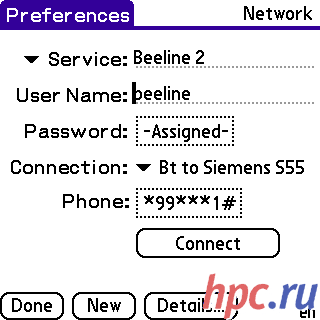 |
Same for Sony Clie SJ-22 and earlier models.
By clicking on the button Details, fall into the menu with more tweaking. For some operators is useful to know and enter the numbers of DNS-servers. Usually enough to put a checkbox on the point of Query DNS. But sometimes the operator for whatever reason ceases to be run automatically assign DNS-servers. It would be enough to throw off the above check, and it will work again.
For Sony Clie same.
Well, the most recent that neither is "shamasnkaya" part - the script will connect. On this subject, you can write a very long time. Script connection may depend on the model of PDA and the phone model and settings from the operator. Often he does not need it. For example, in recent years to the "Beeline" Can not connect without a script. Would look like the script to the most advanced version.
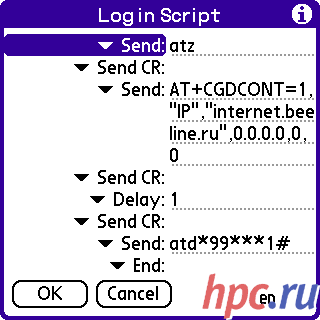 |
Let's look at the script in detail. The first line [atz] - reset the modem. After it follows the termination character string [Send CR]. The second line - this line of pre-initializing the modem. Moreover, all operators, it is about the same. The only difference in the substring APN - in the case of the "Beeline" is - [internet.beeline.ru]. The difference may also be a substring of [0.0.0.0], in some cases it is recommended enclosed in double quotes. Throughout the second line there should be no gaps. The third line [Delay: 1] just a pause, but it is sometimes necessary to call. Well, the last line - is actually dialing up to the operator. Note the lack of space. The script is also helpful to write in any of the profiles, connect it to be at hand.
Field tests: Internet on your Pocket PC and Palm
Tests carried out simply enough. We tested the correctness of the connection of all CPC to all phones and operating ligaments.As a test, download a few similar websites, custom e-mail and it turned out, dispatched a letter to the test. Estimates of the rate of kits and individual devices to very difficult, since a lot depends simply on the network load and the current speed of data transmission.
Internet on your Pocket PC
As with all versions of Windows, the operating system Pocket PC 2002 has established tools for the Internet. They represented a pocket version of Internet Explorer, e-mail client Inbox, in the Pocket Outlook and Instant Message Delivery Windows Messenger.
Pocket Internet Explorer
Browser - the main instrument of research networks. Pocket Internet Explorer has a large enough capacity to handheld standards. Supports several types of encodings, including Russian, working with images, supports cookies, able to change the font size, and customize pages to fit the handheld screen. Among others, there is mute button and the option to download pictures to send links to the page via email. The program keeps a history of visited sites.
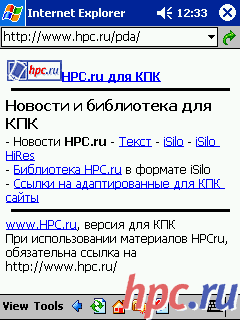 |
 |
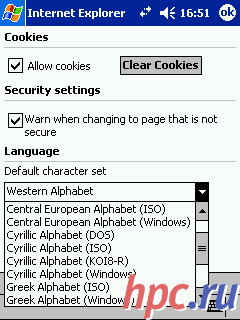 |
After installing the software to synchronize with your desktop computer Microsoft Active Sync, you can bookmark Favorites directly from your desktop computer. With large sites are adequately slow. Opening the home page www.hpc.ru (approximately 200 kb) occurred in about 50 seconds. On a more "light" sites Explorer works faster. The browser allows you to use virtually all elements of the site: click on links, fill out forms, use the conferences. The exception was the Flash-banners that the program just does not show. With all the merits, the program has some negative sides. One of the main - with Pocket Internet Explorer can not browse multiple sites at once, there is a menu item "open in a separate window. So you can travel in one direction only. Also a big minus is that the program can not automatically detect the encoding - you have to choose it manually and reload the page again, that is not the best impact on traffic. It is not possible to deploy the screen and view the contents in full screen. Display and the resolution of the CCP can not boast a large size and presence in its title bar and status bar is not always desirable. Among others, there is no support for animated GIF images and the possibility of saving pages. Positive point is that many of these issues are resolved to install additional programs and utilities, but as they say, you want everything at once. The software market there are a large number of both commercial and free replacement of Pocket Internet Explorer. Despite these shortcomings, the program is quite usable.
Inbox
Modern handheld hard to imagine without the possibility of working with e-mail.In Pocket PC 2002, there is a fully featured mail client Inbox, supports both direct work with mail servers, and synchronize with a desktop mail program.
Functionally, the program was very similar to Microsoft Outlook for desktop PC. Full integration with the phonebook, working with multiple accounts and investments, and to open and process them can be directly on the PDA. When you send MS Office files are automatically converted for viewing on a desktop computer.
With built-in voice recorder, which is also integrated into the Inbox, you can record and send voice messages. In appropriate settings, you can download not the whole letter, but only a part (by default 2 KB), saving bandwidth. Internet connect program can automatically check for new messages at regular intervals. This can be especially useful when using GPRS via Bluetooth. In general, the program has good potential and is able to meet the needs of the user.
Internet for Palm OS
In the case of the Palm OS, everything is not as desirable. Unfortunately, there are built and annexed in a set of tools for working with the Internet is clearly not enough functionality and reliability. Often must use third-party software, performance of which in different configurations, too, leaves much to be desired.
Browsers
Of the most popular browsers and Xiino PocketLink. Both understand Russian charset, pictures, are able to save files on memory cards. Xiino runs noticeably faster and displays the page as the download. PocketLink can operate at high screen resolutions. A Xiino understand certain design styles, JavaScript and CSS. In addition, Xiino pretty good draws pages to display on the screen.
Both browsers are prone to spontaneous lockups, especially when dealing with the unwieldy pages. Therefore, Palm users can recommend to visit the "light" resources are adapted for viewing on a PDA. The number of such resources is growing every day. Cost browsers: Xiino - 25 dollars, PocketLink - $ 20
Mail
With the mail situation is much better. Fairly well established client VersaMail, which comes bundled with the Palm Tungsten T. VersaMail can work with POP and IMAP servers to send and receive attachment, contains tools for viewing certain types of files. Russian-language problems are not noticed, switching required encodings involved crack. Includes VersaMail comes a special software to synchronize email with many different mail clients on Windows-based desktop computer.We must mention one nice feature VersaMail: This program is able to receive from the server only headers of new messages, and the body of letters to download individually only for your selected messages.
ICQ
For Palm there is an official client ICQ. It works more or less normal, but obviously damp and so moody. However, the interface is familiar and fairly well thought out. Use Palm ICQ convenient. Here only the Russian language are sometimes problems. Hopefully, the developers will finish it and get a good tune their product.
Cell phones and PDAs: Our recommendations
Despite the seeming finality of products and well-telephone industry, not every model is obtained successful. Quite often, proper and correct operation of the phone depends on the version of firmware - the program operating the phone and user interaction. Here and in our tests we ran with the leaders and the clear outsider. Siemens S55 - an honest leader. Excellent design and ergonomics, rich functionality and quality performance of both the handset and firmware. Errors and was not locked up. Connecting to PDAs could adjust very quickly and without problems. In short, if there is money - we recommend it. Ericsson T68 - albeit an outdated model, but an attractive price / performance ratio. Errors and hang this model is also not peculiar. Perfectly united with the CPC as the infrared port, or via Bluetooth. The only downside, perhaps, we can assume that when working with menus phone a few hesitate. Recommended as the perfect solution for those who want Bluetooth-phone for little money. And what about LG G7000A anything good, unfortunately, can not say. Aluminum, functionally rich phone with the best of these models display completely refused to work with any PDA. Most likely, it is not functioning correctly the infrared port on the phone or firmware bugs. For those who want to work a lot on the Internet, we recommend to pay attention on Pocket PC. CCP of the platform best suited for surfing and independent work on the network. Stable and well run browsers, email clients and communication with the phone. Palm OS devices still do not fully eliminate the problems of growth, use of these PDAs to surf the Internet more difficult and costly. However, Palm has other advantages over Pocket PC, and many choose this platform. Can recommend the Palm OS to those who are going to use mostly e-mail, occasionally by visiting the web page.
Smartphones and communicators
There is another solution, which should definitely be mentioned. It's smart phones and communicators - devices created on the principle of "two in one." Smartphones - the descendants of conventional cell phones, which have added features PDAs. But communicators - it is rather the CCP, which added phone capabilities.
Smartphones are often designed as a closed solution to the ideology of a regular phone. Most likely, it will be a tube, similar to normal, but with some advanced features. The fundamental difference between smart phones lies on the ability to install and run software third party. Still functional smartphone is fairly limited due to the small number of software platforms and diversity of modest-sized screens. But the smartphone is very convenient to use as a traditional phone.
Communicator - a step to cellular by the CCP. In most cases, the basis of a conventional handheld computer, which integrates GSM / GPRS-module, antenna and a slot for SIM-card. As you can imagine, this device is very convenient for connections to the Internet. In addition, you get a full PDA, which can install any program from the thousands available. Unfortunately, there is a downside - the communicator is not very convenient to use as a phone.
Can recommend the device for those who rarely speaks on the phone, but prefers to SMS and mobile Internet. In recent years, cheap, but it is full of communicators model: for example, Eten P603. According to its PDA capabilities - a standard Pocket PC, and all that was said above about this platform is to Eten P603. This model is most pleasing to the communicator on price / performance ratio at this time.
Summary and Conclusions
A few years ago once again to talk on a cell phone was quite expensive. Now we're seriously talking about the full of the Internet surfing, a fairly capacious traffic. Permanent reduction of tariffs and already quite stable operation GPRS-services offer a pleasant prospect for mobile devices on the Internet. In addition to standard services of GSM-networks, such as SMS, EMS, Voice Mail, now you can also use the full usual e-mail, all kinds of instant messengers, receive news and free to wander the Internet resources. Bundle of Phone + PDA provides a functional, only slightly inferior to a desktop computer. But the main advantage of this tandem again, mobility, and once more mobility. Anywhere, anytime, in any position ...:) Do not doze software developers: Always there are new products - browsers, pagers, SMS and e-mail clients. Constantly updated and improved the already known program. Work with the CPC on the Internet is becoming more accessible. Keep up with the latest and cellular operators. At the recently held in Moscow exhibition "Svyaz-Ekspokomm'2003" Megafon company demonstrated a new service - broadcast video on the protocol GPRS. Moreover, it was not just advertising campaign, and preparing for a commercial project. The emergence of such services clearly indicates that the quality of data transmission over cellular networks will continue to grow and, consequently, will grow and the usability of the mobile Internet. Sources, Materials:
Journal of Mobile Portal - ordering material
The authors, translation:
Anton Kuznetsov
Anton Trapeznikov




















